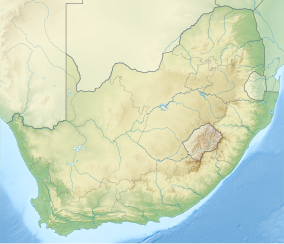Karoo National Park
| Karoo National Park | |
|---|---|
|
IUCN category II (national park)
|
|

Karoo landscape
|
|
|
Location of the park
|
|
| Location | Western Cape, South Africa |
| Nearest city | Beaufort West |
| Coordinates | 32°21′S 22°35′E / 32.350°S 22.583°ECoordinates: 32°21′S 22°35′E / 32.350°S 22.583°E |
| Area | 767.9 km2 (296.5 sq mi) |
| Established | 1979 |
| Governing body | South African National Parks |
| http://www.sanparks.org/parks/karoo/ | |
The Karoo National Park, founded in 1979, is a wildlife reserve in the Great Karoo area of the Western Cape, South Africa near Beaufort West. This semi-desert area covers an area of 750 square kilometres (290 sq mi). The Nuweveld portion of the Great Escarpment runs through the Park. It is therefore partly in the Lower Karoo, at about 850 m above sea level, and partly in the Upper Karoo at over 1300 m altitude. There are two main game viewing drives that do not require a four-wheel drive vehicle: the one to the east remains on the “Lammertjiesleegte” plains of the Lower Karoo; the other is the 49 km long circular route to the west which ascends the Klipspringer Pass on to the plateau (Upper Karoo), and eventually returns to the plains at the "Doornhoek" picnic site at the western extremity of the loop. From there it follows a south-easterly course across the plains to the beginning of the Klipspringer Pass, near the camp site and chalets. At the top of the Klipspringer Pass the Rooivalle View Point presents a magnificent panorama of the Lower Karoo. The middle portion of the park, to the west of the Klipspringer Pass circular route, is easily accessible in 4x4 vehicles, and covers an extensive area, with rewarding game viewing opportunities.
The Karoo National Park is a sanctuary for herds of springbok, gemsbok (or Oryx), Cape mountain zebra, buffalo, red hartebeest, black rhinoceros, eland, kudu, klipspringer, bat-eared foxes, black-backed jackal, ostriches, and, since fairly recently, lions. It also has the greatest number of tortoise species of any park in the world - five in total. The endangered riverine rabbit has been successfully resettled here. A large number of Verreaux's eagles have nests on the cliffs of the Escarpment. Martial eagles, booted eagles and the shy Cape eagle-owl are other raptors that can be seen in the Park. A wide variety of smaller birds occur in abundance, making the Park a birder’s paradise. The park has also been populated with Rau Quagga which are Plains or Burchell's zebras that have been back-bred to resemble the quaggas that roamed the karoo in great profusion until the middle of the 1800s, when they were hunted to extinction. The last quagga died in Amsterdam Zoo on 12 August 1883.
...
Wikipedia

